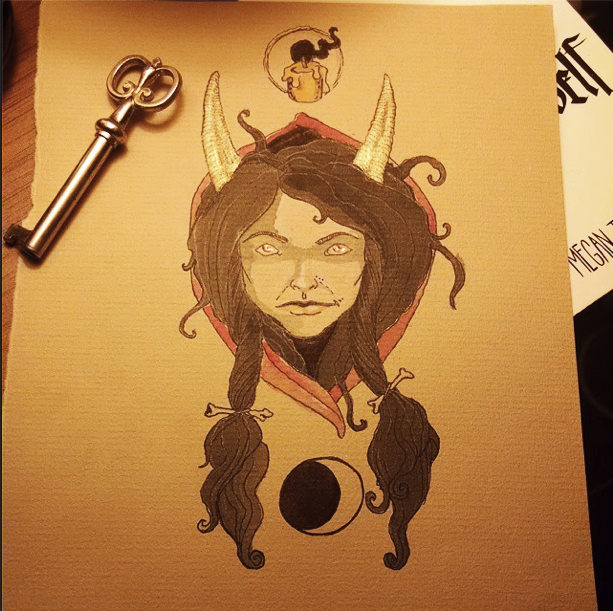|
A happy Solstice and Yuletide to all my sisters and brethren far and near. I hope you passed the time well and didn't drink or feast too much as I did. This time we pass between Christmas and the Epiphany often brings a restful period where business slows, people worship together and visit freely. For us gentle wytchfolk, the time after the Solstice is by no means to remain uncelebrated as well. In my personal practice I have had little to do with Gods and Goddesses. I am more interested in interfacing with the low spirits and genus loci of the region I inhabit. However, these cold, dark days I find myself drawn again and again to one name. Perchta. I can't remember exactly where I first heard her name or read about her, but in exploring my own Bavarian heritage, I feel it must have been then that I stumbled upon her. She is wild. And I mean this in the old sense of "belonging to the forest". She is alarmingly both cruel and kind, attacker and protector, ugly and beautiful, old and young. She is a Goddess of the ancient Southern Germanic peoples, but she has many names, customs and beliefs surrounding her that vary from place to place about the German and Alpine countryside. Much information has been lost about her and her role in the old German's religious lives, for Tacitus' Germania, one of the main sources of information about early Germanic life, focuses mostly on the male powers that were. Surprisingly enough. Lotte Motz, an amazing Austrian-American woman scholar, left us many scholarly papers and a few books concerning Germanic folklore and mythology. She wrote in depth especially about female figures in Northern myth, and quite a bit about Perchta and her many manifestations. Through her papers and the works of John B. Smith, I want to try and paint a picture of this diety, and maybe you will be as inspired to paint her picture or join in her feast day as I was. Perchta is above all, a Goddess of the midwinter time. January 5th or 6th to be more exact. The time of the Epiphany. There is some debate as to whether she stems from Medieval Germany as a personification of the Epiphany feast day, or some prehistoric divinity, or a combination of both. But, as I am sure many of us can understand, the exact historical origin is not always so important as the traditions that grew out of it. It is during this time of the Epiphany that traditionally a special meal is eaten in her honor. Though Epiphany is a Christian holiday, it falls around the times of older feast days. The meal consists of gruel and herring, or dumplings depending on the region. She legendarily becomes quite irrate if her meal is not eaten and will cut open the belly of any offenders and fill them up with refuse and straw. It is difficult to say many definitive things about her early history, because she was most likely mythologized from a Goddess, much like her counterpart Hulda, into a terrible witch. Her name itself helps peel back the cloak that Christianity laid upon her; Perchta means "shining one". It's hard to imagine one to be a frightening witch with such a name. According to Jacob Grimm, she was also the female leader of the Wild Hunt (which is a topic that deserves many posts all its own). Aside from her wild rides across the thundering skies, she is also the overseer of spinning and weaving, much like her Northern cousin, or counterpart depending on who you ask, Holda (Holle, Hulda). I feel John B Smith's paper, "Perchta the Belly Slitter and her Kin" gives a great synopsis of the complexities that Perchta represented: "Initially Perchta was the enforcer of communal taboos, hunting down those who spun on holidays or who failed to partake sufficiently in collective feasting (a propitious act designed to ensure future plenty). However, with the growing involvement of peasant women in the market economy (particularly for textiles), Perchta’s role changed to the punisher of the lazy. Yet Perchta’s previous roles survive, in attenuated form, in each new incarnation." - John B Smith Another remarkable and strange custom that still exists today surrounding Perchta is the "Perchtenlauf". It is a masked procession full of noise making, fireworks and people, generally men, dressed as terrible beasts with large horns. These perchent or followers of Perchta, serve to frighten away the cold, evil spirits of winter by out ugly-ing them. They are so fearsome themselves they aim to scare the very cold away. There were well documented attempts at suppression in the 17th and 18th centuries, but today, these processions have experienced a revival. Following the transformations of a Goddess to a boogeyman-like figure is always interesting to me. To see where a figure was once held dear and sacred, and how she became part of the vernacular post-Christian folk practice, that shows a certain type of deep magic.
There is much, much more to say about Perchta, but I will leave it at this: Blessings upon your midwinter, in Perchta's name. May your houses be found in order and your spinning tidy. Sources: Smith, John. "Perchta the Belly-slitter and Her Kin: A View of Some Traditional Threatening Figures, Threats and Punishments." Folklore 115.2 (2004): 167-86. Web. Motz, Lotte. "The Winter Goddess: Percht, Holda, and Related Figures." Folklore 95.2 (1984): 151-66. Web. Photos from Wikipedia.
0 Comments
Leave a Reply. |
Archives
April 2024
To support me in my research and work, please consider donating. Every dollar helps!
|




 RSS Feed
RSS Feed
